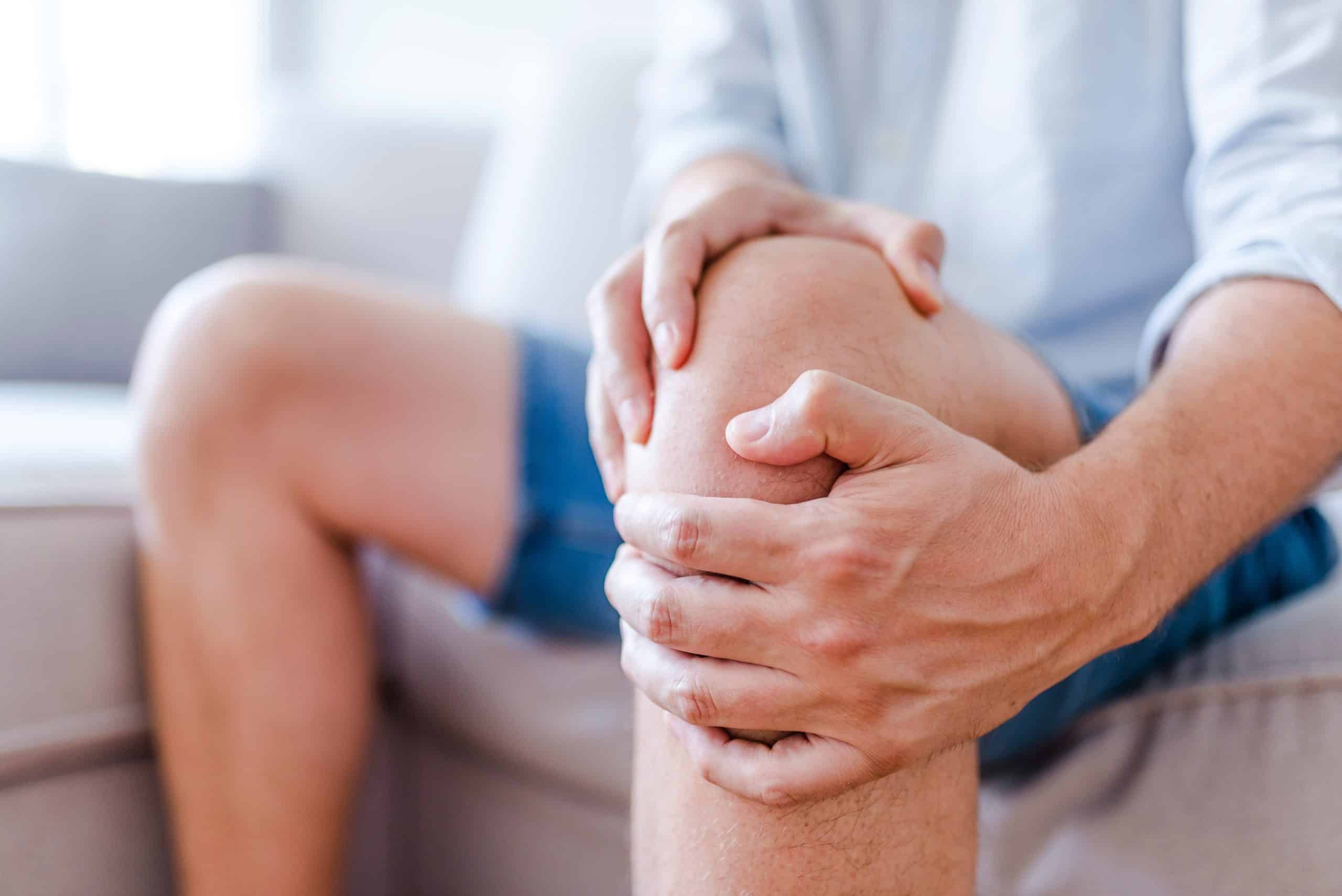Knee Stiffness and Pain: Reasons Why Your Knee Hurts
|
| Our knees lift us up when we are tired, help us to maintain balance and stability, and absorb the impact of our movements. This joint is intimately involved in many of our everyday movements, so experiencing knee pain can be debilitating. |
You might think that a little ache in your knee joint is nothing to worry about, but over time, that minor ache can become a big problem. Your knee is one of your body's most important and complex joints, serving as the shock absorber for your every step. So, it's no surprise that even the slightest discomfort in your knee can significantly impact your overall health and well-being.
In this blog post, we'll explore the various causes of knee pain and stiffness. From the surprising connection between knee osteoarthritis and your patella to the unexpected link between knee pain and ligament injuries, we'll uncover the little things that can make a big difference in knee pain.
What Is the Knee Joint?

Understanding pain starts with understanding anatomy. For example, the knee joint is one of the most complex joints in the body and is made up of several different parts.
The knee joint is composed of three bones: the thighbone (femur), the shinbone (tibia), and the kneecap (patella). These bones work together in a delicate dance, supporting your weight and allowing you to move freely.
When one of these bones is out of alignment, or when the muscles, tendons, and ligaments that support the knee joint are damaged, knee pain and stiffness can pop up.
The meniscus, which are two pieces of cartilage in the knee, serve as shock absorbers, cushioning the knee joint and absorbing the impact of physical activity.
The knee ligaments, including the ACL (anterior cruciate ligament) and the MCL (medial collateral ligament), hold the bones of the knee in place and provide stability. The patella, commonly known as the kneecap, protects the knee joint and helps transfer force from the quadriceps to the shinbone.
In addition to bones, cartilage, and ligaments, the knee joint relies on the surrounding muscles to function correctly. The quadriceps, located in the front of the thigh, work to extend the knee, while the hamstrings, located in the back of the thigh, work to flex the knee. Both sets of muscles play a crucial role in maintaining the stability and strength of the knee joint.
What Are Common Causes of Knee Pain?
Understanding the underlying cause of your knee pain is critical to finding relief. Many factors can contribute to knee pain, from chronic conditions like osteoarthritis to unexpected injuries like sprains and ligament tears.
Knee Osteoarthritis
A common cause of knee pain, osteoarthritis is typically the result of good old-fashioned wear and tear. As the articular cartilage in the knee joint degrades, the bones beneath it start to grind against each other. This friction leads to pain, stiffness, and decreased range of motion in the knee joint.
Rheumatoid Arthritis
This autoimmune condition is a type of arthritis that can lead to knee stiffness and pain. This knee arthritis causes the immune system to attack the joints and typically worsens over time.
Knee Injuries
Sprains, ligaments, and meniscus tears can all cause knee pain. These types of injuries can strike like a bolt from the blue, causing sudden and severe pain in the knee joint.
We've all heard stories about someone who twisted their knee in soccer practice, fell during a game, or took a tumble while running. Such injuries can cause the knee to swell and hurt, making it difficult to walk or even stand.
Patellofemoral Pain Syndrome
Also known as anterior knee pain, this condition occurs when the patella (or kneecap) is out of alignment with the thighbone. This misalignment puts pressure on the patellofemoral joint, causing pain that can range from mild to severe.
Overuse
Engaging in activities that put repeated stress on the knee joint, such as running or jumping, can be like a never-ending workout for your knee. Over time, this repeated stress can lead to pain and discomfort in the knee joint, and if left untreated, it can escalate into more severe problems.
These are just a few of the common causes of knee pain. By understanding the underlying cause of your knee pain, you can take the first step towards finding relief and returning to the activities you love. And remember, don't have a knee-jerk reaction when it comes to knee pain — it's vital to visit a medical professional for proper medical advice, diagnosis, and treatment.
How Is Knee Pain Diagnosed?
It's time to get to the bottom of why your knee hurts. Whether you're dealing with a nagging condition like osteoarthritis or a sudden injury like a sprained knee, figuring out what's going on is crucial to finding relief.
Medical History
Your doctor will ask all sorts of questions about your medical history, physical activity level, and the circumstances surrounding your knee pain. They'll want to know if you've been experiencing knee pain for a while, if you've had any recent injuries, or if you've been doing anything that might have caused the pain.
All this information can help them piece together the puzzle and come up with the best diagnosis.
X-rays
X-rays can help your doctor uncover potential bone problems, such as damage or misalignment, and rule out any underlying conditions, like stress fractures or bone tumors. However, X-rays cannot identify muscular, tendon, or ligament issues.
Physical Examination
Your doctor may also take a hands-on approach to diagnose knee problems. During the physical examination, they'll check your knee for swelling, tenderness, or instability and ask you to move it in different directions.
You'll bend, twist, flex, and extend to see how the knee moves and if it causes discomfort. All this data can help your doctor come to the bottom of why your knee hurts.
How Is Knee Pain Treated?

It's time to talk about kicking knee pain to the curb! After your doctor has sorted through the data and diagnosed the cause of your knee pain, they'll come up with a plan to help you manage your pain.
Physical Therapy
Physical therapy can be an absolute lifesaver for knee pain. Your physical therapist will design a workout specifically for your knee, complete with exercises that can improve strength, flexibility, and range of motion. Think of it as a boot camp for your knee, minus the drill sergeant.
Medications
Over-the-counter pain relief medications, such as nonsteroidal anti-inflammatory drugs (NSAIDs) like ibuprofen, can also be a knee pain game-changer. NSAIDs are powerful pain relievers that help moderate your immune responses, which are believed to be responsible for joint pain.
They can be taken orally, applied topically, or injected directly into the joint to provide targeted relief.
Knee Braces
Knee braces can also be a valuable tool in managing knee pain. These braces support the knee joint, helping to alleviate pain and improve stability. There are several different knee braces available, from simple neoprene sleeves to more complex braces that provide more support.
Knee Surgery
In severe cases, knee surgery may be necessary to alleviate knee pain. Knee surgery can range from knee replacement to ACL reconstruction and is typically recommended when other treatment options have been exhausted.
How Can You Prevent Knee Pain?
Knee pain can be overwhelming, but the good news is that you can take steps (literally and figuratively) to prevent it from happening in the first place! So let's dive into some proactive measures that you can take to keep your knees feeling great.
Maintain a Healthy Weight
We all know that excess weight can take a toll on our bodies, and our knees are no exception. However, maintaining a healthy weight can reduce the stress placed on your knee joints, helping to prevent knee pain.
Stretching and Strengthening Exercises
Stretching and strengthening exercises are a fantastic way to keep your knees in tip-top shape. By working on flexibility and strength, you can help reduce the risk of knee pain and improve the overall health of your knees. So, grab a yoga mat or go to the gym and get those knees in shape!
Wearing Proper Shoes
Wearing proper shoes can make a huge difference in preventing knee pain. Shoes that provide adequate support can help reduce the stress on your knees, potentially preventing pain and injury. Make sure to invest in a good pair of shoes and give your knees the support they need!
Avoid High-Impact Activities
Some activities, such as running or jumping, can put excessive stress on the knee. Avoiding these activities or finding alternative, low-impact options can help prevent knee pain and keep your knees healthy. Think of biking, swimming, or pilates as your new best friends!
The Bottom Line
Knee pain can make it challenging to keep up with your active lifestyle. But, with the right combination of medical diagnosing, treatment options, and proactive measures, you can say goodbye to stiff knees and knee pain.
At Muscle MX, we believe in equipping individuals with tools to take control of their health and live life to the fullest. That's why we offer natural products that support well-being and performance.
Our clean and simple products are made with the finest ingredients and innovative designs and are backed by our commitment to dependable results. So, join us on our mission to conquer knee stiffness and discomfort and experience our natural solutions for yourself.
Sources:
Patellofemoral pain syndrome - Symptoms and causes | Mayo Clinic
Medial Collateral Ligament Injury (MCL) - Penn Medicine
Anterior Cruciate Ligament (ACL) Injuries - OrthoInfo - AAOS












































